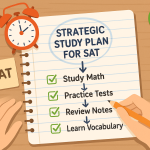The SAT represents one of the most significant academic milestones in your teenager’s educational journey. As a parent, you’re likely feeling the weight of helping them achieve their best possible score while navigating the overwhelming array of tutoring options available today. With college admissions becoming increasingly competitive, choosing the right SAT preparation strategy can make the difference between your child reaching their dream school or settling for their backup option.
Understanding the landscape of SAT tutoring isn’t just about finding someone to teach test-taking strategies—it’s about identifying the approach that aligns with your teen’s learning style, schedule, and academic goals. This comprehensive guide will walk you through everything you need to know to make an informed decision that sets your child up for success.
Understanding Your Teen’s SAT Preparation Needs
Before diving into tutoring options, it’s crucial to assess where your teen currently stands. The SAT tests critical reading, writing and language, and mathematics skills that students have developed throughout their academic career. However, succeeding on the SAT requires more than just subject knowledge—it demands specific test-taking strategies, time management skills, and familiarity with the exam format.
Start by having your teen take a practice SAT under timed conditions. This baseline score will help you understand their strengths and weaknesses across different sections. Pay attention not just to the overall score, but to patterns in their performance. Do they struggle with time management? Are there specific math concepts that consistently trip them up? Does anxiety affect their performance on reading comprehension passages?
Consider your teen’s learning preferences as well. Some students thrive in competitive group environments where they can feed off the energy of their peers. Others perform better with individualized attention that allows them to progress at their own pace and focus on their specific challenges. Understanding these preferences early will help you choose the most effective tutoring approach.
The Spectrum of SAT Tutoring Options
Traditional Classroom-Based Programs
Large test preparation companies like Kaplan and The Princeton Review have long dominated the SAT prep landscape with their classroom-based programs. These programs typically feature structured curricula delivered in group settings with 10-20 students per class.
Advantages:
- Comprehensive curriculum covering all SAT sections
- Structured learning environment with set schedules
- Often more affordable than private tutoring
- Peer interaction can motivate some students
- Access to extensive practice materials and resources
Disadvantages:
- One-size-fits-all approach may not address individual weaknesses
- Limited flexibility in pacing and focus areas
- Large class sizes mean less individual attention
- Fixed schedules may conflict with extracurricular activities
- May not be ideal for students who need significant score improvements
Online Group Courses
The digital revolution has transformed SAT preparation, with online platforms offering group courses that combine the structure of classroom learning with the convenience of remote access. These programs often feature interactive elements, recorded lessons for review, and digital practice tests.
Advantages:
- Convenience of learning from home
- Often less expensive than in-person options
- Access to recorded lessons for review
- Interactive features and gamification can engage tech-savvy students
- Flexible scheduling options
Disadvantages:
- Requires strong self-discipline and motivation
- Limited real-time interaction with instructors
- Technical issues can disrupt learning
- May lack the accountability of in-person instruction
- Difficult to gauge student engagement and understanding
Private One-on-One Tutoring
Private tutoring represents the gold standard of personalized SAT preparation. This approach involves working directly with a qualified instructor who can tailor every aspect of the learning experience to your teen’s specific needs, learning style, and goals.
Advantages:
- Completely personalized curriculum and pacing
- Immediate feedback and clarification of concepts
- Flexible scheduling to accommodate busy student schedules
- Ability to focus intensively on weak areas
- Development of confidence through individualized attention
- Adaptation of teaching methods to match learning styles
Disadvantages:
- Higher cost compared to group options
- May lack the motivational aspect of peer interaction for some students
Hybrid Approaches and Specialized Programs
Many modern tutoring services combine elements from different approaches to create hybrid programs. These might include small group sessions supplemented by individual coaching, or online platforms with live tutoring components.
Key Factors to Consider When Choosing SAT Tutoring
Timeline and Goals
Your preparation timeline significantly impacts which tutoring option will be most effective. Students beginning preparation a year or more before their test date have the luxury of exploring different approaches and making adjustments. Those with shorter timelines need more intensive, focused preparation.
Consider your teen’s target score improvement as well. A student aiming to improve from 1200 to 1300 might succeed with a structured online course, while someone needing to jump from 1000 to 1400 likely requires intensive, personalized instruction to address fundamental gaps in knowledge and test-taking strategies.
Learning Style and Personality
Introverted students who prefer working independently might excel in online self-paced programs, while extroverted learners might thrive in group settings. Students with attention difficulties often benefit from the focused environment of one-on-one tutoring, where the instructor can adapt to their needs in real-time.
Consider how your teen responds to different types of motivation. Some students are driven by competition with peers, while others perform better when they can focus on personal improvement without comparison to others.
Budget Considerations
SAT tutoring costs can vary dramatically. While budget is certainly a consideration, it’s important to view SAT preparation as an investment in your teen’s future. A higher SAT score can lead to merit-based scholarships that far exceed the cost of tutoring.
When evaluating costs, consider the total value package. A slightly more expensive option that includes additional resources, practice tests, and ongoing support might provide better value than a cheaper alternative with limited offerings.
Geographic and Scheduling Constraints
Your location and schedule constraints play a practical role in determining viable options. Families in rural areas might have limited access to quality in-person tutoring, making online options more attractive. Busy student-athletes might need the flexibility of online or private tutoring that can work around their competition and practice schedules.
The Rise of Personalized Online Tutoring
The evolution of educational technology has created exciting new possibilities in SAT preparation. Modern online tutoring platforms combine the personalization of private tutoring with the convenience and technological advantages of digital learning.
This approach addresses many of the traditional limitations of both in-person and online learning. Students can work with highly qualified tutors from anywhere in the world, accessing expertise that might not be available locally. The technology enables real-time interaction, screen sharing for problem-solving, and digital whiteboards for explaining complex concepts.
Personalized online tutoring platforms can track student progress meticulously, identifying patterns in mistakes and adjusting instruction accordingly. This data-driven approach ensures that tutoring time is used efficiently, focusing on areas where the student needs the most improvement.
For busy families, the convenience factor cannot be overstated. Students can access high-quality tutoring from home, eliminating commute time and scheduling conflicts. Parents can often observe sessions remotely, staying involved in their teen’s progress without disrupting the learning process.
What to Look for in a Quality SAT Tutor
Regardless of the format you choose, the quality of instruction remains paramount. When evaluating potential tutors or programs, consider these essential qualities:
Subject Matter Expertise: Your tutor should have deep knowledge of the SAT format, recent changes to the test, and effective preparation strategies. Look for tutors who regularly take the exam themselves to stay current with trends and question types.
Teaching Experience: SAT tutoring requires different skills than traditional academic tutoring. Effective SAT tutors understand how to break down complex test-taking strategies into manageable steps and can help students develop the mental stamina required for the lengthy exam.
Personalization Ability: Even within group settings, quality tutors can provide individualized attention and adapt their instruction to different learning styles within their classroom.
Communication Skills: Tutors must be able to explain concepts clearly and provide constructive feedback that motivates rather than discourages students. They should also communicate regularly with parents about progress and areas of concern.
Track Record of Success: While past performance doesn’t guarantee future results, tutors with documented success stories and positive testimonials demonstrate their ability to help students improve their scores.
Making the Final Decision
After evaluating your options, involve your teen in the final decision-making process. They’ll be doing the hard work of preparation, so their comfort level and enthusiasm for the chosen approach will significantly impact their success.
Consider starting with a trial period or initial consultation to assess the fit between your teen and the tutoring approach. Many quality programs offer money-back guarantees or trial periods that allow you to make adjustments if the initial choice isn’t working.
Remember that SAT preparation is not just about improving test scores—it’s about building confidence, developing problem-solving skills, and creating positive study habits that will serve your teen throughout their academic career. The right tutoring approach should address all these aspects while preparing them for test day success.
Supporting Your Teen Through the Preparation Process
Regardless of which tutoring option you choose, your role as a parent remains crucial throughout the preparation process. Create a supportive home environment that facilitates focused study time. Help your teen maintain a balanced schedule that includes adequate rest, nutrition, and stress management.
Stay involved in their progress without becoming overbearing. Regular check-ins about their confidence level and areas of concern can help you identify when adjustments to the tutoring approach might be necessary.
Celebrate small victories along the way. Score improvements, mastery of difficult concepts, or simply consistent effort all deserve recognition. This positive reinforcement helps maintain motivation throughout what can be a challenging preparation period.
Looking Ahead: The Investment in Your Teen’s Future
Choosing the right SAT tutoring approach is one of the most important educational investments you can make for your teenager. The skills they develop through quality SAT preparation—critical thinking, time management, test-taking strategies, and academic confidence—will benefit them not just on test day, but throughout their college career and beyond.
When evaluating options, platforms like Sparkl represent the evolution of SAT preparation, offering personalized one-on-one live tutoring that combines the best aspects of traditional private tutoring with the convenience and technological advantages of online learning. This type of individualized attention allows tutors to identify and address each student’s unique challenges while building on their strengths.
The right tutoring investment today can open doors to better college options, merit-based scholarships, and increased confidence in your teen’s academic abilities. By taking the time to understand the options available and making an informed choice based on your teen’s specific needs, you’re setting them up for success not just on the SAT, but in their entire academic future.
Remember that the goal isn’t just a higher test score—it’s empowering your teenager with the skills, confidence, and knowledge they need to succeed in their educational journey and beyond. With the right support and preparation approach, your teen can achieve their SAT goals and unlock the doors to their dream college and career path.
















No Comments
Leave a comment Cancel